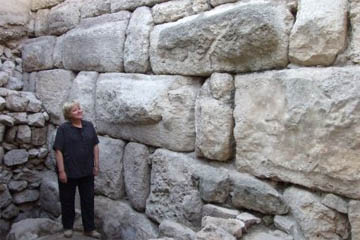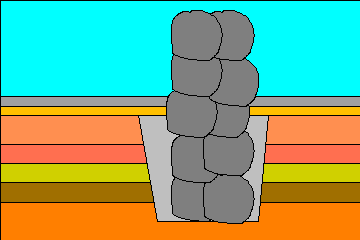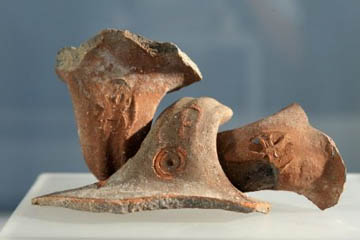Solomon's Walls
Eilat Mazar, the controversial Israeli archaeologist who claimed to have discovered the ruins of David's palace in the "City of David", only yards from the entrance to Hezekiah's Tunnel, has come up with another startling claim.
For the last three months Mazar has been re-excavating in the Ophel area, which was first excavated in the 1970s. Further work was done in the area by the late Dr Benjamin Mazar, assisted by his grand-daughter, Eilat! Those excavations were exciting enough in themselves: among the discoveries were Umayyed houses and a palace, a warren of buildings from the time of Christ, many of which were equipped with their own, private mikveh for ritual washing, and a huge cistern which the archaeologists interpreted as being the remains of the Akra, a massive fortress held by the Seleucid forces long after Judas Maccabeus had liberated the rest of Jerusalem. For years, until they were driven out, the Greek soldiers harrassed worshippers in the temple with a desultory rain of arrows from the ramparts which overlooked the temple courts.
For me, however, the most important discovery was a broad staircase dating from the 1st century AD. The stairs led up from the south to the temple mount via a couple of doorways that are not bricked up but whose outline is still clear to be seen in the wall around the Haram. The date and the location mean that those stairs were almost certainly used at some time by Jesus and His disciples - and as authentic remains associated with Christ are few and far between, it was interesting to stand on the steps and imagine the scene when they were crowded with pilgrims ascending or descending on their way to or from the temple, and among them a Galileean rabbi with His band of fishermen and tax collectors.
If anyone thought that the area had been completely excavated, however, Mazar says that they are due for a suprise. She claims to have identified - not discovered (a point I will deal with below) - a wall that dates to the tenth century BC and which may be part of the city wall built by King Solomon as part of the building work undertaken in connection with the Jewish temple. Her work is not sponsored by the Israeli government, but by two American Jews from New York, Daniel Mintz and Meredith Berkman.

|
| Dr Eilat Mazar poses beside the wall which she claims was built by Solomon. |
On the face of it, Dr Mazar's claim is a strong one. The wall is built of large stones - which in itself argues a strong and rich central power able to command the labour necessary for such monumental construction. The stones have been cut with a wide margin and substantial (but rough) central boss, and then laid in a header-stretcher manner. Both of these features are characteristic of "Israelite" masonry. Leen Ritmeyer points out that the claim to a Solomonic origin seems strengthened by the fact that the newly identified masonry and that of the oldest parts of the eastern wall of the Haram appear to be very similar.
After that, however, things start to go downhill. This wall and a gateway and tower that appear to be related to it were first investigated by Charles Warren, a British army officer who got around Turkish restrictions on excavating in the sacred area of the Old City by digging wells. The fact that his well had no prospect of ever reaching water, and in fact turned horizontal as soon as it was underground and out of sight of authority, did not appear to ring any alarm bells with the Turks and he was enabled to explore large areas by means of tiny tunnels barely large enough to crawl through. Excavators still occasionally come across one of his tunnels, showing that he got there first! Warren referred to his tower as "the Extra Tower" or "the Projecting Tower".
In the 1960s, a century after Warren had first investigated the area, Dame Kathleen Kenyon excavated here and uncovered the tower round which Warren had dug his tunnel. By this time archaeologists had a chronology built on pottery as well as primitive and expensive carbon-14 dating, and Kenyon dated the tower to the 8th century BC, possibly built by King Hezekiah. If, as the construction techniques appear to indicate, the tower and Mazar's wall are linked, then this would date the wall to the 8th century BC as well. Indeed, this is the point made by Ritmeyer, who has previously suggested that the section of the eastern wall of the Haram in question was built by Hezekiah.
Mazar claims to have found pottery that dates the wall, but as Kenyon pointed out in her careful re-excavation of Jericho, walls are very chancy things to date! Let's look at some of the problems.
If you excavate a house and find it filled with pottery from 800 BC, you would naturally assume that the building and its walls date from 800 BC. You may even find that the plaster floor has been extended up the walls, linking them with the contents found on that floor. Yet it may be that one or more of the walls pre-date the floor by a considerable period of time - particularly if the building you are excavating is an outhouse built against the city wall or the wall of a palace.
Ok, so then you start to dig down outside the wall and buried in the fill beside the wall is a pot from 900 BC. A foot below that is another pot from 850 BC (you would expect older material to be deeper down than the younger material!) and a little lower still is a pot from 920 BC. Unless you have been very careful, you will have missed the fact that all this material is "fill" - that is, rubble dug up when the foundation trench was being dug and then rammed back into the hole after the stones have been put in place. However we will kindly assume that you did notice that fact: in which case this is exactly what you would expect. The builders dug their trench down through the strata from the time of the wall being built as far as 920 BC, then tossed the dirt back in a glorious jumble, which is why you have pots being discovered "out of order" in the fill.

|
| In this diagram you can see how only the top two strata cover the fill and therefore post-date the construction of the wall. You can also see how tempting it might be to date the wall by the earliest stratum on which it sits. |
So in despair you decide to dig up the nicely preserved plaster floor and see what you can find inside the building. In fact, what you discover is that at one end of the house the floor rests on bedrock while at the other, the floor rests on dirt mixed with Neolithic pottery. Now what do you conclude? The answer is, that you conclude that the builders brought in rubble from elsewhere to level the floor area and just happened to pick on a source rich in Neolithic pottery!
A really skilful excavator will notice that the fill extends so far up the wall, but at a certain point the fill is covered by a stratum which goes right up to the wall. That stratum represents the period when the wall was built.
Garstang's mistake at Jericho was to date the walls on the basis of the latest stratum through which the wall was dug, which is why he dated walls to Iron Age I which in fact dated back to the end of Early Bronze. Even in more recent times similar mistakes have been made - and it may unfortunately be the fact that Eilat Mazar is making the same mistake again.
A few years ago she published an article entitled, "The Solomonic Wall in Jerusalem" in which she recounts the discovery of a wall which she dates to the tenth century BC, along with a four-chamber gatehouse and a royal building - discoveries which curiously match the ones she has recently announced. Even the diagram published in this article bears a remarkable resemblance to her most recent finds! Revealingly, she described a small black jug, found underneath the wall, which she dated to the 10th century and which she claimed was a foundation deposit - ie. an object deliberately buried beneath a wall or building as an offering to the gods.

|
| These pot handles discovered by Mazar are said to be inscribed 'lmlk' or 'for the king'. |
This is an interesting claim, but if it was true it would be very unusual. Foundation deposits usually consisted of an assemblage of objects, some deposits included the remains of sacrificial animals, in other lands there might be cuneiform tablets recording the builder of the wall. One single jug, albeit unbroken, would be most surprising. It is far more likely that the jug was buried intact in the normal course of events and the builders of the wall stopped short of it when they dug their foundation trench. In other words, that the jug pre-dates the wall by a considerable period of time.
This conclusion is supported by an article in "The New Encyclopaedia of Archaeological Excavations in the Holy Land" which describes, among other things, the four-chambered gatehouse and states, "The first stages of these buildings date to the ninth century BC at the earliest."
In short, while I would like to believe Mazar, I have to conclude that there are serious questions about her claims - in particular, why she is pretending that old discoveries are new. It could be, of course, that she simply feels that her conclusions did not receive sufficient attention last time round and hopes that fresh publicity will lead to vindication of her interpretation of the discoveries she made back in 1986/7 with her grandfather. The less charitable will point out that the funding offered by Mintz and Berkman is about to run out and if she wants to eat, let alone continue to excavate, she needs new sponsors - and the surest way to find those is to announce something dramatic, particularly if it appeals to the Jewish desire to find remnants of their past glory.
Needless to say, Palestinian sources have loudly condemned the discovery while settler groups have welcomed it. Both sides regard the discovery as strengthening Jewish claims to Jerusalem, but both are overlooking the simple point that facts are facts and if Mazar has found something, condemning her is a stupid waste of breath. In any case, past ownership of the land is no guide to present ownership, for if Mazar will dig a little deeper she will find that Jerusalem was originally inhabited by Jebusites - and nobody wants to see them back in power!
© Kendall K. Down 2010





